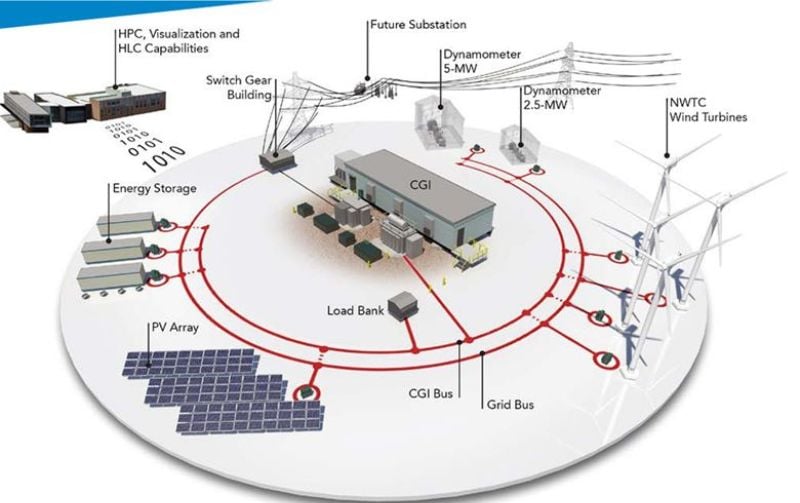NREL’s Second Real-Time Controllable Grid Interface Transforms Renewable Energy
The National Renewable Energy Laboratory constructed the Controllable Grid Interface a decade ago to help test emerging renewable energy technologies in real time without relying on simulations. With the rapid deployment of renewable energy projects, NREL is constructing a second CGI to accommodate the rising demand for safe, well-vetted, clean energy innovations.
The testing, research, and development phases for emerging renewable energy technologies are crucial. Without thorough examinations of how new systems and equipment interact with the utility grid, dangerous consequences can ensue when novel challenges arise. To help improve testing conditions, the National Renewable Energy Laboratory (NREL) built the Controllable Grid Interface (CGI) on its Flatirons campus in Colorado, and over 50 projects have used NREL’s 7-MW CGI to refine renewable energy systems before they are deployed.
The Flatirons campus in Colorado, where the CGI tests new tech. Image used courtesy of NREL
The CGI can create a smaller scale but real-time grid testing environment so that new systems can be used, observed, and changed to counteract liabilities and strengthen weaknesses. With new energy mandates from governmental reform and a veritable gold rush in burgeoning renewable tech sectors, the need for safe and thorough testing is greater than ever. NREL will meet this need by building a second CGI, in development since 2018, and will soon be able to defray some of the demand shouldered by the original CGI.
The Challenges and Limitations of Simulations
Because many renewable energy technologies are truly the first of their kind, there is a critical need for testing scenarios to capture on-the-ground application conditions. Simulations and modeling are often used in research, but they have inherent limitations and can lead innovation astray when the simulation obscures how actual applications might perform.
For example, battery testing for electric vehicles has proven problematic because the lab struggles to simulate real-world drivers. The result is compromised battery and algorithm performance rooted in skewed data from “perfect” testing environments. The same challenge has presented itself in solar panel development. It is difficult to create the simultaneous stress of variables that compromise solar panel performance in the real world, such as heat, humidity, and weather events, so lab testing panels can be misleading and produce data that lacks utility.
The Specs of the CGI
NREL’s CGI was created to provide such utility and meet this pressing need. The idea came in a workshop with wind energy stakeholders concerned about research for upcoming projects.
The CGI is isolated from the actual utility grid but is also a microcosm of it. It is fully controllable and can replicate grid performance through a complex interplay of multiple elements. The 7-megavolt amperes CGI system is connected on-site with megawatt dynamometers linked to megawatt-scale turbines. The ecosystem also includes access to a motion platform, a framework of electrical and mechanical storage elements, and a connection to NREL’s supercomputer, which has advanced capabilities to test the grid as an actual operating utility system.
A diagram of the CGI and various elements from the campus needed for its operation. Image used courtesy of NREL
As a fully functioning system, the CGI and the devices surrounding it can test virtually any condition the actual utility grid might face: compliance with standards, performance during staged grid failures, fault testing, voltage surges, and more.
The capabilities of the CGI have drawn many manufacturers and research partners who need such full-scale testing to see how both active and reactive power control features will perform.
The Future of CGI-2
Over the years, NREL has improved the CGI by adding electrical lines and relocating transformers to accommodate the addition of junction boxes and electrical conduits. However, too many projects can benefit from the CGI’s capabilities, so the construction of a second CGI (CGI-2) began in 2018 and was nearly complete at the end of 2022. It is currently undergoing a final round of vetting from various experts.
CGI-2 will add a 20-MW grid at the Flatiron campus, giving it access to the same integrated energy system built over the past ten years.
Diagram of CGI-2’s placement on the Flatiron campus. Image used courtesy of NREL
The combination of experts at NREL and the capacities of the original CGI and forthcoming CGI-2 are helping to develop industry standards and move research forward so renewable technologies can be rolled out safely and in a timely manner to support the global shift to clean energy.









